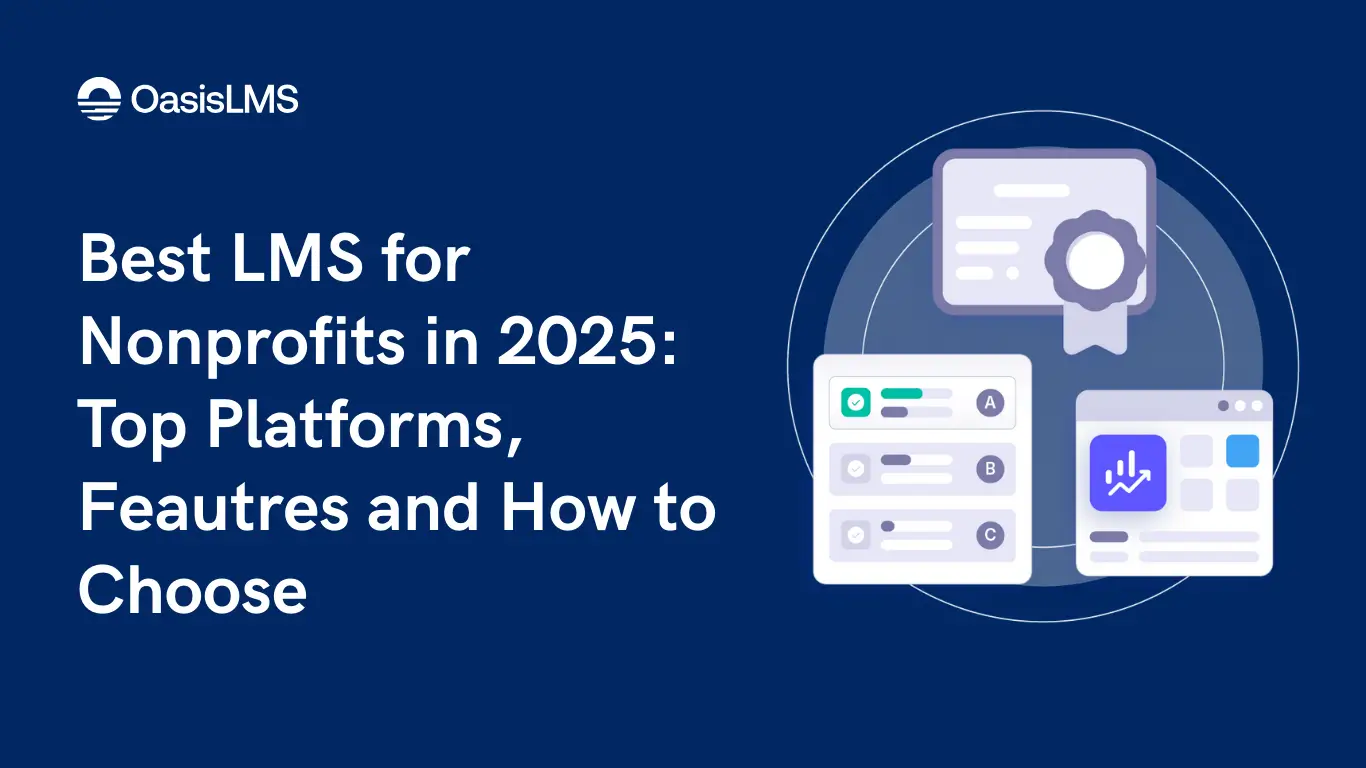
For nonprofits, education is more than transaction, it’s away to amplify your mission. If you are training volunteers, onboarding staff, delivering programs to your community, or offering CE, a learning management system (LMS) will increase operation efficiency and expand your reach.
However, with limited budgets and staff, choosing the right LMS is not only about what features it has. It’s about finding a true partner to help you fulfil your mission. In this guide, we discuss the best LMS platforms for nonprofits in 2025, what features have the most impact, and how to find the right tool for your non-profit.
Nonprofits are tasked with world changing goals but small margins. An LMS enables you to deliver consistent, scalable training without going over budget.
If your organization is still relying on PDFs, in-person workshops, or scattered tools for educational delivery, you could be missing out on both efficiency and engagement.
Instead of repeating on premise sessions or hiring trainers (even volunteers), create digital content once and deliver it forever, whether 10 or 10,000 learners.
Whether it's CPR training, code of conduct modules, or board onboarding, the best LMS will give you documentation and reporting to satisfy grants, audits, and stakeholders.
Modern LMS platforms offer quizzing, evaluation, and tracking of learner progress. This allows you to identify what’s working and what’s not.
With flexible, on-demand content, volunteers can train on their schedule, increasing volunteer engagement and retention.
Bring all your content, certifications, tracking, and analytics under one roof. Goodbye spreadsheets and piecemeal tools.
Not all LMS platforms are created for the same purpose. Nonprofits’ needs are often different from those of corporations or universities. Here’s what you should consider:
Nonprofits need affordable solutions with pricing that scales. Look for platforms that do not nickel and dime you.
Your staff and volunteers are likely not technology experts. Prioritize platforms that are intuitive for your learners which increase engagement.
Support for videos, SCORM, quizzes, live webinars, downloadable resources, and mobile learning is a must.
Whether you offer training for internal needs or external audiences, look for support for branded certificates, digital badges, and tracking progress.
Connect your LMS to your CRM (like Salesforce), email system, donor database, or community platform to increase efficiencies for both administrators and learners.
You’ll need data for grant reports, strategic decisions, and impact measurement. The best LMS platforms give you these reports at your fingertips.
Make sure your LMS is usable on phones and tablets, and is WCAG compliant to ensure accessibility.
Let’s break down some of the top LMS options available to nonprofits today, starting with one built specifically for flexible, mission-driven education delivery.
Best for: Nonprofits that offer professional development, testing or large-scale training.
Oasis LMS is trusted by associations, medical institutions, and a number of nonprofit organizations. Its architecture, intuitive interface, and powerful reporting tools make it ideal for nonprofits that need flexibility, and scalability without an IT department.
Why Nonprofits Choose Oasis LMS:
Standout Feature: Robust certification and credentialing engine that supports branded certificates and continuing education workflows. This is perfect for nonprofits offering education as a service.
Bonus: Oasis LMS pricing is built for nonprofits.
Best for: Nonprofits that prioritize live cohorts, peer-to-peer learning, and community-building.
Teachfloor is a modern LMS built for collaborative education. It allows organizations to host live sessions, asynchronous content, and community discussions all in one place.
Highlights:
Best for: Nonprofits with technical expertise that want maximum flexibility at low cost.
Moodle is a globally used, open-source LMS that’s entirely free to use, though you’ll need IT resources to host, maintain, and customize it.
Highlights:
Best for: Small to mid-sized nonprofits looking for a quick and user-friendly solution.
TalentLMS combines ease-of-use with flexibility. It supports blended learning, automation, and multilingual content.
Highlights:
Best for: Nonprofits with a need for interactive training and compliance programs.
iSpring Learn integrates tightly with PowerPoint and offers top-tier tools for building interactive, multimedia-rich courses.
Highlights:
Best for: Mid-sized and global nonprofits with multi-language, eCommerce, or integration needs.
Paradiso LMS is a flexible, enterprise-grade solution that supports nonprofits offering training for a fee or at scale.
Highlights:
Picking an LMS from hundreds of options can be overwhelming. However, it doesn’t have to be. Here’s a step-by-step process tailored for nonprofit decision-makers:
Are you training volunteers, educating the public, or generating revenue through certifications? Your goals should guide your selection.
Understand who your learners are: full-time staff, part-time volunteers, board members, or external audiences? This affects usability and features.
List must-have features like mobile access, multilingual support, CRM integration, or certification tools.
Many LMS vendors offer nonprofit pricing or grants. Be upfront about your budget constraints.
Before committing, test the LMS with a small group. Look for user feedback, ease of administration, and whether it meets your engagement goals.
Learning is one of the most powerful tools in the nonprofit playbook. Whether it’s building skills, spreading awareness, or scaling impact. The right LMS partner helps your non profit scale and do it better with a great learner experience.
As you evaluate the best LMS for your nonprofit in 2025, consider more than just price or features. Look for a partner who understands your mission and empowers you to achieve it.
Whether managing CME for physicians or supporting member growth, Oasis LMS helps deliver high-impact education efficiently and at scale.
